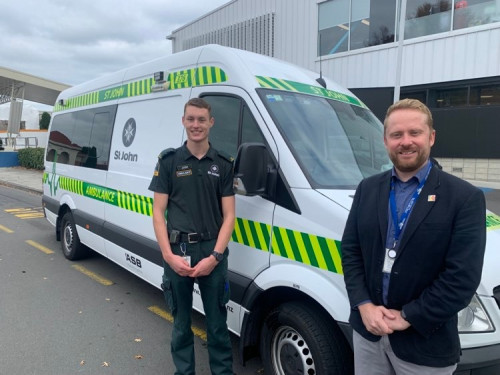
Pictured: Hawke's Bay DHB Chief Operating Officer Chris Ash with St John Patient Transfer Officer Josh Kluts.
Hawke’s Bay District Health Board is funding two St John patient transport ambulances gaining exclusive use between 8:30am and 8:30pm Monday to Friday and 10am to 6:30pm on weekends to better support more timely patient transfers and improve hospital flow.
St John patient transfer services are different to emergency ambulances. The transfer services are dedicated ambulances that safely transport patients to or from hospital to locations such as aged residential care facilities, flight ambulance services, as well as palliative support to home or hospice.
Chief Operating Officer Chris Ash said today the new funding agreement, effective from 1 May, was good news for patients, St John and the district health board, as it would release patients ready to be discharged sooner and keep emergency response vehicles on the road.
“Up until now there has been one patient transfer ambulance the DHB contracted for transport needs but upon review it was clear more supports were needed with growing pressure on St John, the hospital system itself, and often extended delays for patients awaiting their turn in the queue, based on acuity, for transfer out.
“This had a flow-on effect – it was unsettling for patients and whānau and it also meant new patients requiring beds were having to wait until others were formally discharged out.”
St John Deputy Chief Executive for Ambulance Operations Dan Ohs said providing two St John patient transport ambulances and staff to the DHB for exclusive periods across seven days, was an excellent way to improve services both for the DHB and community, while also complimenting the delivery of the emergency ambulance service.
“Effective patient flows are essential to ensure that there is capacity within the hospital network to enable patients to be admitted. Effectively when a patient transfer ambulance is available to move patients between facilities and discharge them home – this vacates a bed that could be allocated to patients coming in by emergency ambulance – so win-win for everyone.”






Post your comment
Comments
No one has commented on this page yet.